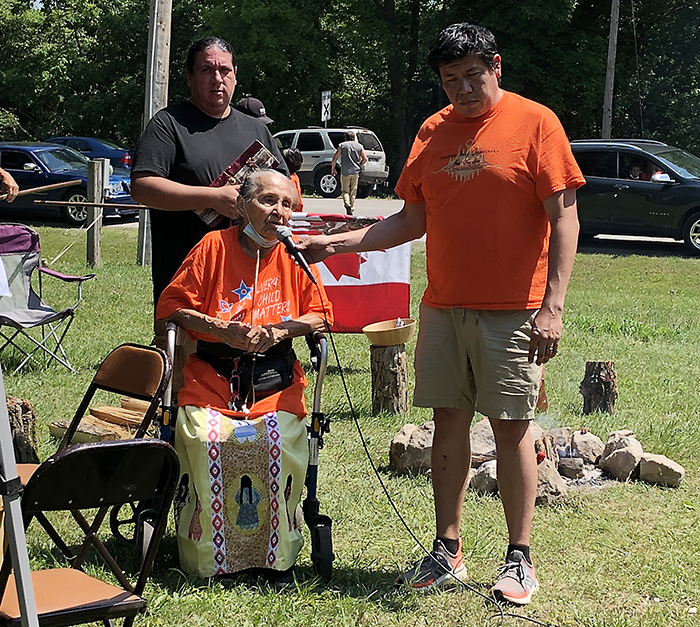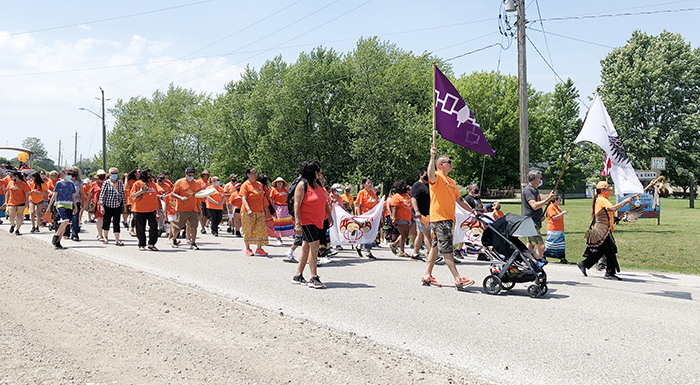
Barbara Riley, a Walpole Island elder and residential school survivor, speaks to a gathering Friday to honour the 215 Indigenous children discovered in a mass grave at a residential school in Kamloops B.C. recently.
By Pam Wright
Local Journalism Initiative Reporter
Barbara Maryann Riley isn’t her real name.
That’s what appears on the Walpole Island elder’s birth certificate, but she was originally called Waubano Kwe.
The Anishinaabe name means ‘one who is born on the cusp of dawn.’
But nearly a century ago, officials told her parents they couldn’t use it, so they opted for the Barbara moniker instead.
The 89-year-old woman, the eldest of 13 children descending from the Potawatomie and Ojibwa tribes, is a residential school survivor. She attended the Shingwauk Indian Residential School in Sault Ste. Marie from age 12 to 16.
It wasn’t a choice.
“The Indian agent decided,” Riley said, adding she, like scores of other Indigenous children from across Canada, was plucked from her family and transported to a strange and hostile existence far from home.
Riley, along with other survivors, was among the mourners who gathered Friday to honour the 215 Indigenous children discovered in a mass grave at a residential school in Kamloops B.C.
Organized by community member Tina Aquash, whose father is also a residential school survivor, the event saw an orange wave of hundreds march in tribute from Walpole Island’s elementary school to the residential school survivors’ monument.
Dozens wore T-shirts emblazoned with the message “Every Child Matters.”
In her message, Riley encouraged her community to learn about and draw from the richness of their culture, and to share the knowledge with the children.
“Whatever we do as adults is important,” Riley told the gathering. “What we do, our children do. We are their primary teachers.”
Riley doesn’t share many details about her harsh experience at Shingwauk, except to say it was abusive. Boys and girls were separated, and even if you had brothers or cousins on the other side of the school, you weren’t allowed to talk to them.
Children were punished at every turn, isolated, made to work like adults, and forbidden to speak their language.
“We were obedient,” Riley said. “We got in line and marched like soldiers. Once in a while we got to play.”
Before being taken from the reserve, Riley was a tomboy who loved the outdoors.
Raised by her paternal grandmother after her mother died, Riley absorbed the teachings and traditional ways.
At seven, Riley started her government education at a school on Walpole. Classes were taught in English, but she didn’t speak it at all. She remembers having to learn words one by one, saying them out loud and writing them on a chalkboard.
At the time, Walpole was a natural paradise. There were only five vehicles on the Island, and, with the exception of government officials, no white people.
“There were only native people here; just us,” she said. “They (whites) were afraid to come here.”
Riley said she didn’t receive any kindness from Caucasian people until she was in adulthood. She remembers going with her grandmother to a Wallaceburg shoe store and being refused service.
“I never met a kind Caucasian person for years and years,” she said.
At 12, she and her sister were taken to Shingwauk. The boarding school was one of 130 Canadian residential schools. It was operated by the Anglican Church of Canada and the Canadian government from 1873 to 1970.
Riley was more fortunate than others. Her father Russell Riley was a successful businessman building docks and boathouses on the American side of the St. Clair River.
Because the family had money, he was able to bring Riley back and forth from the residential school for holidays and assist her in leaving Shingwauk when she was 16.
At 17, she left Walpole Island and moved to Detroit to make her fortune. But the scars of residential school ran deep. When she was introduced to drinking liquor, a long period of alcoholism began.
Although she worked, got married and had four children while living in Michigan, alcohol was her daily companion.
When her son Mike was in high school, he told his mother she needed help.
Riley sobered up in 1973 and never looked back.
She began working as a secretary for a supportive boss she met through recovery. Eventually, she went to school part-time, obtaining a Master’s Degree in Social Work from Wayne State University.
She returned to Walpole from the U.S., where she served as a counsellor, and she also set up employment services for First Nation people.
Riley’s star continued to rise as she worked on her career and her healing. She went on to become a tenured Professor of Social Work at Laurentian University, the first Indigenous person in Canada to do so, and has taught Indigenous studies at many Canadian universities.
She was also a Lambton College faculty member.
“I’m almost 90 and I have lived a long, good life,” Riley said. “But I didn’t realize the wealth of my culture until I got sober.”
As a survivor and social worker, Riley is well acquainted with the problems inflicted on First Nation people by colonialism and residential schools.
The fact that Christian European colonial values were thrust upon North America’s Indigenous people amounted to genocide, Riley explained, adding the number of First Nation people slaughtered by settlers is greater than the number of Jews killed in the holocaust.
The effects of sexual, physical and emotional abuse from residential schools are far reaching, she added, breaking and scarring families, but she believes the tragic discovery in Kamloops will lead to change.
“We’ve got to begin to look at the truth,” she said, noting history books need to reflect what really happened to Canada’s Indigenous people.
“We’ve been living too long in a fallacy and a dysfunctional system. It’s a big lie. It’s no good for anybody. It haunts us to this day.
“It took away our confidence and our gifts.”







